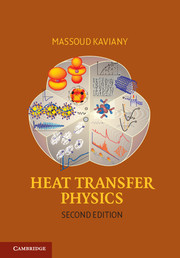Book contents
- Frontmatter
- Dedication
- Contents
- Preface
- Acknowledgments
- 1 Introduction and Preliminaries
- 2 Molecular Orbitals/Potentials/Dynamics and Quantum Energy States
- 3 Carrier Energy Transport and Transformation Theories
- 4 Phonon Energy Storage, Transport, and Transformation Kinetics
- 5 Electron Energy Storage, Transport, and Transformation Kinetics
- 6 Fluid Particle Energy Storage, Transport, and Transformation Kinetics
- 7 Photon Energy Storage, Transport, and Transformation Kinetics
- APPENDIX A Tables of Properties and Universal Constants
- APPENDIX B Derivation of Green–Kubo Relation
- APPENDIX C Derivation of Minimum Phonon Conductivity Relations
- APPENDIX D Derivation of Phonon Boundary Resistance
- APPENDIX E Derivation of Fermi Golden Rule
- APPENDIX F Derivation of Equilibrium, Particle Probability Distribution Functions
- APPENDIX G Phonon Contributions to the Seebeck Coefficient
- APPENDIX H Monte Carlo Method for Carrier Transport
- APPENDIX I Ladder Operators
- Nomenclature
- Abbreviations
- Glossary
- References
- Index
5 - Electron Energy Storage, Transport, and Transformation Kinetics
Published online by Cambridge University Press: 05 June 2014
- Frontmatter
- Dedication
- Contents
- Preface
- Acknowledgments
- 1 Introduction and Preliminaries
- 2 Molecular Orbitals/Potentials/Dynamics and Quantum Energy States
- 3 Carrier Energy Transport and Transformation Theories
- 4 Phonon Energy Storage, Transport, and Transformation Kinetics
- 5 Electron Energy Storage, Transport, and Transformation Kinetics
- 6 Fluid Particle Energy Storage, Transport, and Transformation Kinetics
- 7 Photon Energy Storage, Transport, and Transformation Kinetics
- APPENDIX A Tables of Properties and Universal Constants
- APPENDIX B Derivation of Green–Kubo Relation
- APPENDIX C Derivation of Minimum Phonon Conductivity Relations
- APPENDIX D Derivation of Phonon Boundary Resistance
- APPENDIX E Derivation of Fermi Golden Rule
- APPENDIX F Derivation of Equilibrium, Particle Probability Distribution Functions
- APPENDIX G Phonon Contributions to the Seebeck Coefficient
- APPENDIX H Monte Carlo Method for Carrier Transport
- APPENDIX I Ladder Operators
- Nomenclature
- Abbreviations
- Glossary
- References
- Index
Summary
The solid electric thermal conductivity tensor Ke, in addition to the phonon thermal conductivity tensor (i.e., total conductivity K = Ke + Kp), determines heat conduction in solids through the Fourier law qk = −K · ∇T. The heat capacity of an electron cυ,e when in local thermal equilibrium with the lattice (i.e., phonon) is small, except at very high temperatures. Electrons can also have a net motion under an applied electric field ee, thus creating opportunities for exchange of their gained kinetic energy, e.g., with the lattice through inelastic scattering in Joule heating. The coupling of electronic and thermal transport, known as thermoelectricity, leads to Peltier heating/cooling.
In Section 2.6.5, we examined the electronic energy states of an idealized electron gas by solving the Schrödinger equation for the case of a collection of free electrons while for metals the conduction electron density ne, c does not change with temperature, for semiconductors ne, c(T = 0 K) = 0 for intrinsic (non-doped) semiconductors and increases with temperature. In Section 2.6.6 we also derived the electronic energy states of hydrogenlike atoms, along with the designation of the quantum numbers and atomic orbitals. As atoms gather in a cluster or a bulk phase, their orbiting electrons and their energy states are altered because of various nuclear and electronic interactions (Section 2.2), including representation as interatomic potentials. These interactions may increase or decrease the energy gaps between the electron orbital states of individual atoms.
- Type
- Chapter
- Information
- Heat Transfer Physics , pp. 306 - 433Publisher: Cambridge University PressPrint publication year: 2014



